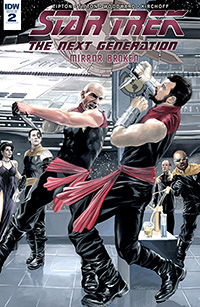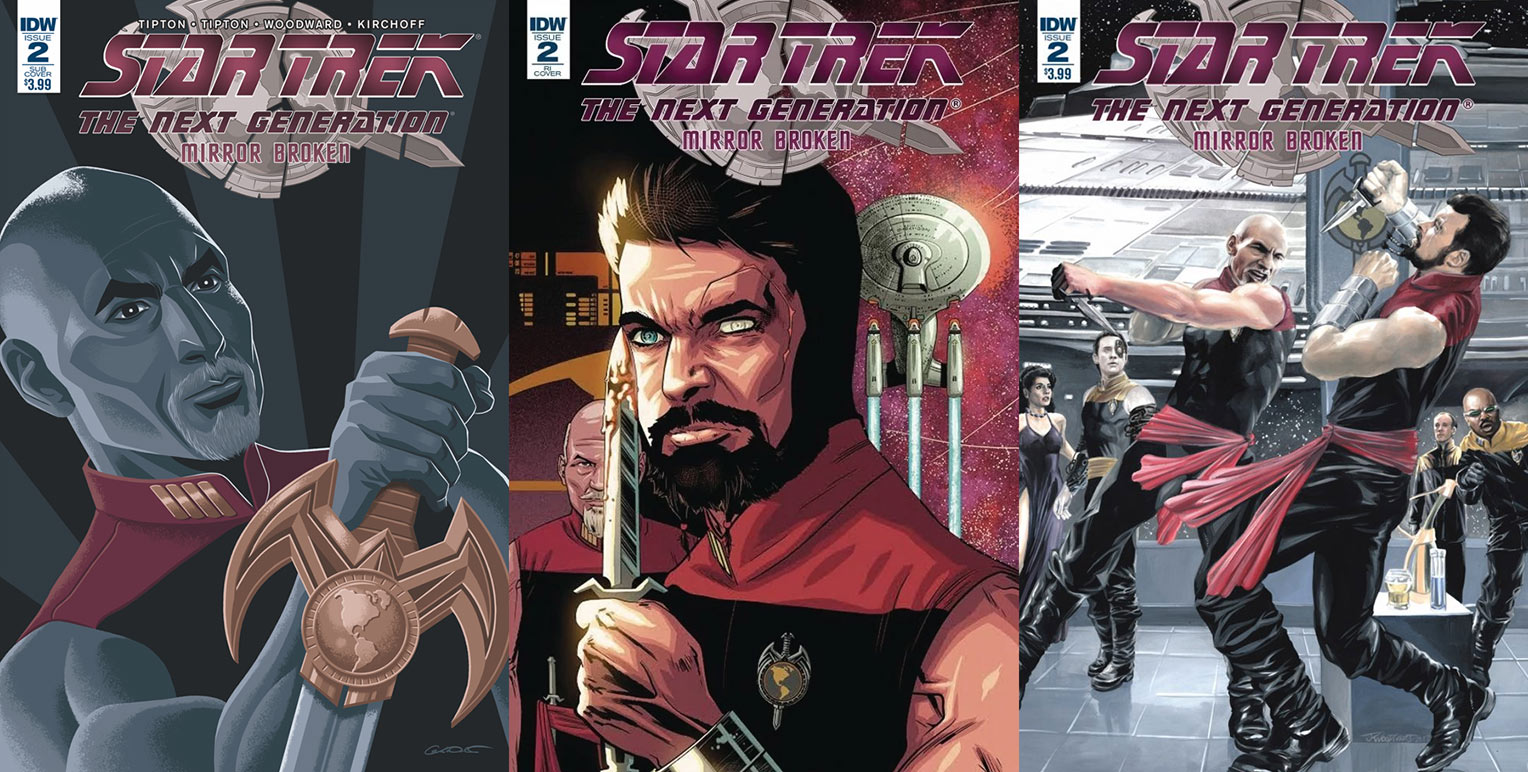Did you ever wonder how Scott and David Tipton or J.K. Woodward, would manage to advance their careers if they lived in the mirror universe? If so, the nature of the universe they were in would probably dictate their behavior into resorting to unscrupulous means to promote their work, trash competitors and bludgeon up-and-coming talent that could threaten their livelihoods. I just wonder how that would appear?
But here’s the thing: their talent would remain the same.
There’s a misapprehension that the mirror universe is a reverse universe; in that the duplicate characters are simply reversed in all of their behaviour and personalities. Good is simply bad, and so forth. But it isn’t; it’s just slightly modified in that people are simply differently self-motivated yet retain their abilities, talents and ambitions as well as a degree of ruthlessness that would never fail to shock.
In Mirror Broken #2, we see Jean-Luc Picard express his desire for promotion from the ISS Stargazer manifest itself in a scheme to steal a revolutionary new Galaxy-class starship known as the Enterprise … but first he needs its first officer, namely William T. Riker, on-side with his plans.
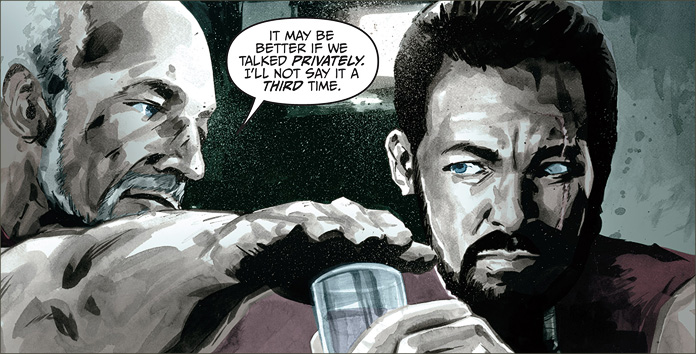
Presently, the Enterprise is commanded by – as this universe’s incarnation of Picard describes him – “an insipid fool,” namely Captain Jellico. Fans will remember this captain who temporarily commanded the Enterprise from TNG’s “Chain of Command.” Of course, he’s the commander that fans may want to see dead, so you have to appreciate the Tiptons’ sense of humour in choosing this captain that Picard will aim to supplant in this issue.
There are slices of backstory carefully woven into this issue of the main characters who we have encountered to this point. Picard, we already know is an expert hand-to-hand combat fighter, but to see his abilities hard-pressed to defend himself in this cruel universe reminds us of the differences in this universe.
Plus, Deanna Troi, referred to as “Inquisitor” and to have Picard state that he has learned to keep things from her also show us the juxtaposition of dependence and distrust that he has for the officers he has chosen to accompany him to loftier perches.
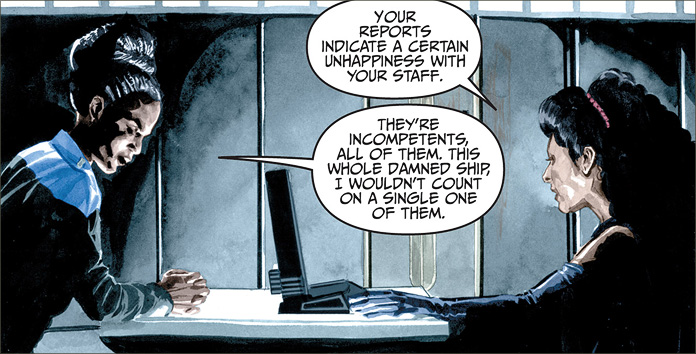
Then there are the minor characters in this story who surprise us with their appearances. Dr. Leah Brahms, as you will remember to be Geordi LaForge’s crush in “Booby Trap,” makes an appearance in this issue as a collaborator to LaForge’s part in Picard’s scheme. This is just an example of the Tiptons’ expertise with the TNG franchise as they intricately weave these fan-favourite details for readers to discover and enjoy.
This story is an absolute twisted delight to what fans already know. The Tiptons take applaudable and honourable features of the crew we know from TNG and turn them into something that shows the callous and manipulative reality of this universe; a direct contrast to the utopian vision of the future fans can appreciate.
But the meat of this story has to be the epic fight between Riker and Picard. While the Riker we know fully respects his captain; in this comic, it’s up to Picard to literally pummel Riker into submission to earn his respect. Violence and treachery serve as ways to advancement in this universe and serve instead of compassion and dedication.
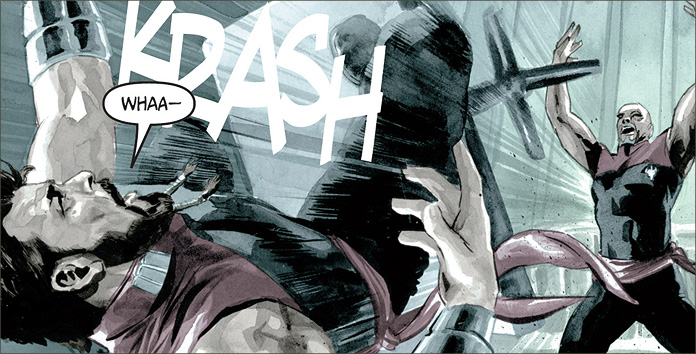
Scott and David Tipton show their gifted abilities in their easy manipulation of these familiar characters in turning them into people completely new but wholly understandable; in fact, Scott tells me that that the fight sequence was the most enjoyable sequences he’s had to write — and he wrote the Shatner/Heston fight in the Planet of the Apes crossover!
But this unequivocally shows how connected the Tiptons are to Trek to be able to do this with such ease. After all, the mention of such a deep-cut reference to chief engineer Leland T. Lynch is a wonderful Easter Egg that every TNG fan can appreciate, and we can thank David Tipton for that one!
(Also, J.K. Woodward’s homage to Morn serving drinks at Morbo’s Bar is certainly a source of amusement for folks who want to pour over the pages in appreciation!)
- There are three covers to this book. Let’s start with the subscription cover by George Caltsoudas. A usual cover artist choice for the Trek titles that IDW puts out, this one features a solitary portrait of Captain Picard. Armed with standard issue Imperial dagger, the criticism I have for this image is that the dagger does not look like the usual square-hilted Terran Empire one that we have seen in three incarnations of Mirror Universe Trek. I also don’t think that Caltsoudas’s art-deco style is something that fits this book. However, if there was a Terran Empire propaganda cover, then that would have been an excellent choice for Caltsoudas.
- The retailer-incentive cover, by Josh Hood and Jason Lewis, looks particularly fierce. The one-eyed and scarred William Riker is a stark realization of the deadly nature of this second universe and definitely reinforces the difficulty of the hurdle that Picard has to overcome in order to win this battle-scarred veteran over to his side. I’m not familiar with Hood’s work so this is an excellent introduction.
- Finally, the regular cover, by J.K. Woodward is definitely the best one of the lot. This guy’s painting talent is an intense exercise in appreciating detail. Plus, as the fight scene in this book is the real action. it’s great to see an artist who can relate to the content of the book by creating a dynamic cover that will actually entice the reader to open the pages. Plus, his talent is simply amazing and a painted book is always a pleasure to appreciate. It’s like the luxury edition of a comic.
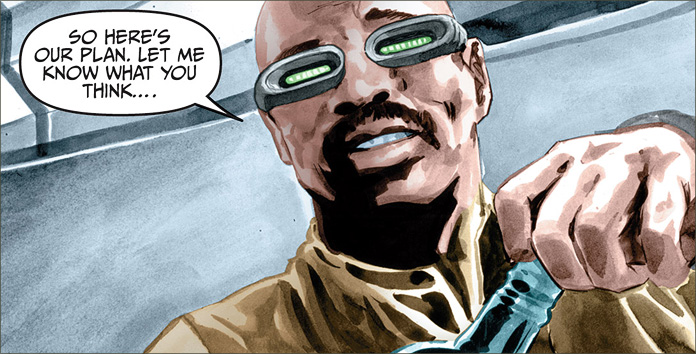
This is a clearly successful series and definitely ranking in the best that IDW can offer to its Trek line. But I still can’t help but wonder what the Tiptons and Woodward would be like in the Mirror Universe.
In any event, it’s clear that they’d still be successful – after all, talent remains the same in both universes, right?

